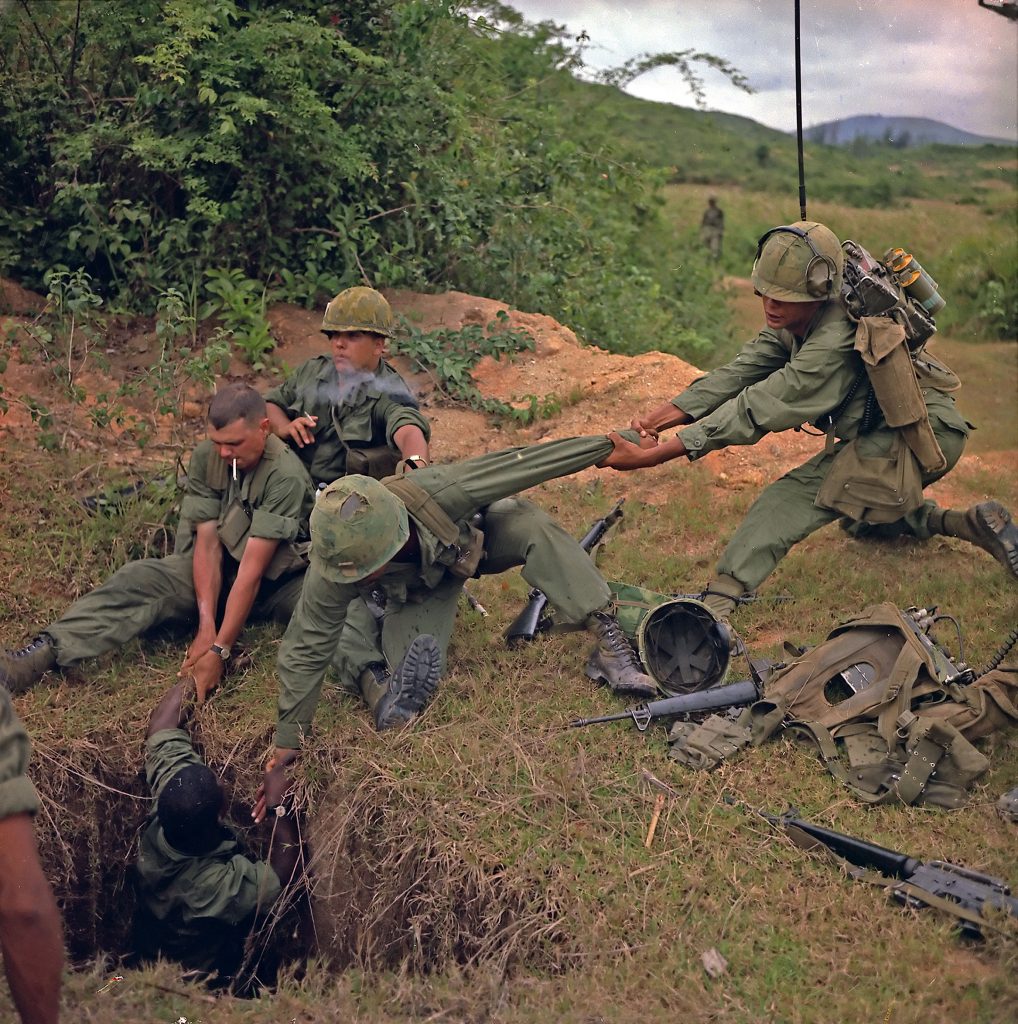If you ever see a flashlight coming your way, you can fire away, but more than likely, you are already a dead man.1
January 7, 1966. The war in Vietnam was raging and the United States had only just begun sending regular combat units as opposed to advisers the year prior. President Lyndon Baines Johnson was steadily escalating the United States’ involvement in Vietnam in an effort to “combat communism.” Eight thousand men descend on a freshly bombed area, hoping to clean up the remnants of Viet Cong in a search and destroy operation. However, when they approached the bombed area, known as the Ho Bo woods, they found nothing but empty fortifications and some rice, evidence that there were once many more men there. The leaders of the Joint American-Australian force were stumped. Where could the Viet Cong have gone?2

They received their answer when one young American soldier sat down to rest, then began exclaiming that he had been stung or bitten on his nether regions. As he began to search for the offending creature, he discovered that what had “stung” him was a nail, protruding from a wooden hatch. This hatch covered a massive underground complex known as the Cu Chi tunnels, spanning some fourteen miles; and this was only one of many tunnel complexes in South and North Vietnam.3 The presence of these tunnels meant that future search and destroy operations would be failures as well, if the tunnels were not dealt with. These tunnels gave the Viet Cong a way to attack U.S. troops from behind, after they had passed overhead; then they could quickly slip back into their tunnels and seemingly vanish. The tunnels also allowed them to hide during bombing runs and as American tanks and helicopters flew by, effectively hiding them from the brunt of American military might. The tunnels could be destroyed using explosives, but these tunnels housed barracks, ammunition and food depots, hospitals, clinics, armories, and rooms with vital military intelligence. These things were often too deep in the tunnels to be destroyed by a blast at the mouth of the tunnel, as the Viet Cong designed their tunnels so that blasts could only destroy small segments. The tunnels were very well made, with sharp right angles every few meters to baffle the blast of an explosive charge, and they had breathing holes dug by taking rabbits and gophers to the bottom of a tunnel and letting them dig themselves back to the surface. After several attempts using tear gas, Acetylene gas, and explosives to flush out the tunnels failed, a new plan emerged. Someone would have to enter the tunnels.4
And thus, the “tunnel rats” were born. These were men, generally small in stature to better fit the small tunnels designed for the smaller Vietnamese physique, and without fear of tight spaces or total darkness, although these are things many tunnel rats would develop after their time in the underground complexes. Armed with nothing more than a flashlight, which was hardly ever used for fear it would alert Viet Cong to the Tunnel rat’s location, a handgun, and a combat knife, sometimes wearing a battery-powered headset, connected to a long cable to let them relay information back to their comrades waiting at the mouth of the tunnel, these men would be lowered into a tunnel, and begin their search.5 Originally made up of men from the famous “Big Red One” 1st Infantry Division present at the original discovery of the Cu Chi tunnels, “tunnel rats” became an unofficial description for someone who had volunteered for this job. This work was mentally and physically taxing, with many volunteers giving up the duty after a few runs, or in many cases, a close call with a Viet Cong soldier in the dark confines of a cave.6
Part of the reason it was such a loathed experience was due to how dangerous an ordeal exploring the tunnels was. If an American tunnel rat were to run into a Viet Cong soldier, the encounter would devolve into hand to hand combat, as firing one’s pistol was very dangerous in tunnels that were barely shoulder-width.7 Firing the large .45 caliber M1911A1 pistol one was issued would definitely lead to ruptured eardrums. This led many of these men to bring captured Vietnamese-used Russian pistols or guns brought from home that were of a smaller caliber–.22 and .38 caliber revolvers being particularly common–that could be more safely fired in the small confines of the tunnels.8

The dangers did not end there either, as the tunnels were frequently booby-trapped, sometimes even with poisonous or venomous snakes and insects, or they had dangerous pits filled with water or gas designed to keep these things away from their living areas of the tunnels. The tunnels were frequently incredibly hot and humid, cramped, sometimes as small as 2.6 feet tall by 2.5 feet wide, and full of unpleasant stagnant air, prompting many tunnel rats to don gas masks in an attempt to make breathing easier.9 Even exiting a tunnel was not safe, as a tunnel rat could travel some distance while underground, then emerge elsewhere, potentially startling a nearby American soldier, which could lead to him being shot. Many tunnel rats would bring smoke grenades with them to use to alert any nearby troops that a friendly would be emerging from a tunnel.10 Because of these hardships, tunnel rats soon gained a reputation as being very courageous, smart, and incredibly lucky to escape a tunnel without dying, and the tunnel rats themselves began to use the motto “Non gratum anus rotendum” or “not worth a rat’s ass.”11
Even with these difficulties, the majority of tunnel rats were very successful. The tunnel rats of the 1st Infantry Division, the only one with any kind of formal training, was especially successful. Consisting of a number of men formally trained to enter the tunnels, radio operators to communicate with them, a medic and a pair of former Viet Cong who could act as translators, the team, led by Sargent Robert Woods, killed 3 Viet Cong soldiers and captured 153 more in a tunnel in August of 1968, just to name one of their most impressive raids. Outside of the formally trained 1st Infantry Division, the volunteer tunnel rats of other companies were sometimes successful as well, securing vital military intelligence, an enemy hospital, or sometimes stores of weapons; these captures accounted for a large portion of seized Viet Cong weapons.12
The tunnel rats where born out of necessity. The United States military had little experience with non-conventional warfare, and needed to adapt quickly to the guerrilla warfare employed by the Viet Cong. During the Vietnam War, even the Australian armed forces had their own “tunnel rats” whom they called “ferrets,” and with the Soviet war in Afghanistan in the 1980s, many Soviet soldiers faced similar hardships in the tunnels of the Mujahideen. Even today, the United States Marine Corps faces similar issues in fighting the Taliban in the cave-like “Kyareses,” or irrigation tunnels of Afghanistan.13 The tunnel rats of Vietnam were one of the first adaptations that the U.S. military made to prepare itself for a new type of warfare, unlike the conventional wars the U.S. had fought in before. But as the number of US casualties from Vietnam rose, American public opinion shifted from support to dissatisfaction, ultimately leading to the United States pulling out of Vietnam, but not before the United States military had learned valuable lessons about guerrilla warfare.

- James Gillam, “Death dance in the dark: James Gillam’s most terrifying moments in Vietnam came in the pitch-black darkness of an enemy tunnel,” Vietnam, 2011., 52, Academic OneFile, EBSCOhost ↵
- Encyclopedia of the Vietnam War: A Political, Social, and Military History, 2011, s.v. “CRIMP Operation,” by Chris Tomas. ↵
- Encyclopedia of the Vietnam War: A Political, Social, and Military History, 2011, s.v. “CRIMP Operation,” by Chris Tomas. ↵
- Encyclopedia of the Vietnam War: A Political, Social, and Military History, 2011, s.v. “Cu Chi Tunnels,” by Richard D. Starnes; “South Viet Nam: The Tunnel Rats,” Time, March 4, 1966. ↵
- Encyclopedia of the Vietnam War: A Political, Social, and Military History, 2011, s.v. “Tunnel Rats,” by James T. Gillam. ↵
- Encyclopedia of the Vietnam War: A Political, Social, and Military History, 2011, s.v. “Tunnel Rats,” by James T. Gillam. ↵
- “I’m not alone down here!” Vietnam, September/October 2015, 42. ↵
- “South Viet Nam: The Tunnel Rats.” Time, March 4, 1966. ↵
- Encyclopedia of the Vietnam War: A Political, Social, and Military History, 2011, s.v. “Tunnels,” by Scott R. Demarco. ↵
- “I’m not alone down here!” Vietnam, September/October 2015, 42. ↵
- George C. Herring, “Vietnam Remembered,” The Journal of American History 73, no. 1 (1986): 152-64; Encyclopedia of the Vietnam War: A Political, Social, and Military History, 2011, s.v. “Tunnel Rats,” by James T. Gillam. ↵
- Encyclopedia of the Vietnam War: A Political, Social, and Military History, 2011, s.v. “Tunnel Rats,” by James T. Gillam. ↵
- Timothy Gusinov, “‘Kyareses’: Taliban’s Death Trap or Escape Route?” Military Intelligence Professional Bulletin 28, no. 2 (April 2002): 46. ↵



58 comments
Marco Picardo
I couldn’t even imagine crawling through such so small and dark places. I knew nothing about these “tunnel rats” before reading this article. It was very informative with great lively images to help illustrate the tunnels themselves. Based on the images, I know for a fact that I’d have a hard time conjuring the courage to go into one of those tunnels.
Megan Barnett
What an amazing article! I had never heard of the tunnel rats before but the title really stuck out to me and grabbed my attention. I especially liked the detail that was put into the description of the tunnels as well as the pictures because when I first started reading I imagined them to be very different so it is nice to have a clear image. It is interesting to know different ways other countries fight wars but it is also cool to see how Americans can overcome these new tactics .
Mariah Cavanaugh
Wow, what a fascinating article! I cannot imagine what the soldiers had to go through to prepare themselves for searching the tunnels. I am claustrophobic and the thought of squeezing myself into such a small space is horrifying. They were not only in extremely cramped quarters but they also ran the risk of running into the Viet Cont. Your article did a great job of what it was like from the soldiers prospective.
Michael Mandujano
This article of the Tunnel Rats of Vietnam provides incredible depictions of the 1st Infantry Division’s American soldiers. In fact, I cannot imagine myself being able to withstand confined areas, hot and humid conditions, nor being clueless about approaching booby-traps. The dangerous conditions that our U.S Military Unit’s experience are nerve-wrecking. Most importantly, I enjoyed reading this article because it provided myself with greater knowledge of how the honorable “Tunnel Rats,” strategized and executed.
Mark Martinez
An amazingly written article that reminds us how brutal warfare can be. Not only was the idea of creating the tunnels brilliant, but how they were strategically made as well. Using tunneling animals to build air ways to the surface would never have accrued to me. The will showed by American and Australian solders to travel into complete darkness will only 2 feet of space is not something everyone has.
Alexis Renteria
Interesting article, in informing the reader about this type of guerrilla warfare. I myself hadn’t heard of the term tunnel rats until now. I’m aware of guerrilla warfare that was used in the war but never had I heard of this term. I agree that tunnel rats were brave and smart in performing their duties to our forces. I cant even imagine the type of toll it took on a person when going into a really tight and dark tunnel with nothing but a flashlight and a handgun to defend yourself against enemies. Overall this was a great story and it shows how much we should appreciate the roles of tunnel rats.
Cameron Ramirez
I had never heard the term “tunnel rats” before so I was very curious about what it meant when I selected this article. The United States 1st Infantry Division “tunnel rats” risked their lives to crawl into a very narrow, totally dark tunnel had valor and bravery that many of their fellow soldiers respected them for it. Your article was very informative and interesting.
Robert Rees
I had heard of the term “tunnel rats” before, in fact I’ve been told that I would have been one, had I been alive during the war. What surprised me was the fact that some of these soldiers were actually trained to enter these tunnels. From the stories I was told, I was lead to believe that the soldiers that would become “tunnel rats” were just the ones unlucky enough to be chosen to investigate the tunnels. The article was well written and surprised a couple of times.
Cristian Medina-Lopez
I thought this article was interesting not only because it was something I got interested in but because it was very informative and kept me hooked the whole time. I thought it was so ironic that the one place the soldier sat at, it was where there was a nail sticking out and revealed to them the whole tunnel system below. Not only was this smart, but it was very strategic to give them more time and an advantage.
Briana Myers
It is really incredible how the Viet Cong created the tunnels in order to gain the upper hand on the war. The fact that they were able to survive in those tunnels is astonishing. I cannot imagine how hard it must have been to get through the tunnels unscathed. They definitely came up with a good way to try and win the war.